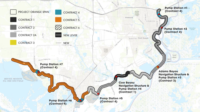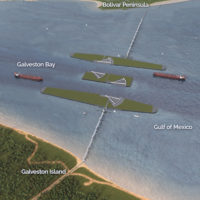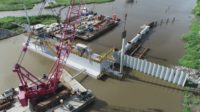A $863-million effort to improve hurricane flood protection and resilience, including levees and floodwalls, for a 65-square-mile area that includes Port Arthur, Texas, and adjacent communities will move forward under a contract awarded to a joint venture of Freese and Nichols, COWI and CDM Smith (FCC-JV) by the U.S. Corps of Engineers Galveston District and Jefferson County Drainage District No. 7 for some of the work.
The Port Arthur and Vicinity (PAV) project is a part of the Corps Sabine Pass to Galveston Bay Coastal Storm Risk Management (CSRM) Program. Also known as S2G, this program covers 120 miles of the upper Texas coast, and will improve existing hurricane flood protection in Port Arthur and Freeport.
Specific elements of the S2G project include: increasing the level of performance and resilience of the existing Port Arthur and Vicinity Hurricane Flood Protection Project (HFPP) in Jefferson County, Texas; construction of a new 26.3-mile levee/floodwall system within Orange County that begins near the intersection of Interstate 10 and the Sabine River and ends southwest of Orangefield, Texas; and increasing the level of performance and resiliency of the existing Freeport and Vicinity HFPP project in Brazoria County, Texas.
“So, essentially you have three separate projects all making up one systematic approach to Coastal Texas resilience,” says Charles Wheeler II, project manager with the Corps Galveston District.
The project will include raising 27.8 miles of earthen levee and floodwall, replacing 26 closure structures and adding pump station wall protection as well as integrated erosion protection features.
FCC-JV will be assisting the Corps on designing the PAV03A segment, which includes raising approximately 5.5 miles of levee and floodwall features, pump station fronting wall protection and roadway and railroad closure gate structures. The PAV03A project is on an aggressive 12-month design schedule as a result of Bipartisan Budget Act of 2018 high-priority project requirements.
Congress authorized the Corps in 2018 to take action on the Sabine Pass to Galveston Bay, Texas Coastal Storm Risk Management and Ecosystem Restoration Final Integrated Feasibility Report – Environmental Impact Statement, which was published in May 2017.
“Specifically for Port Arthur, we have the reinforcement of existing levees in Port Arthur with the Jefferson County Drainage District No. 7 serving as the non-Federal sponsor for this project,” Wheeler says. “Some of the biggest challenges the Corps faces during design and construction are the amount of pipeline relocations we find on our current system. There will need to be substantial coordination between all parties to successfully accomplish this task.”
Wheeler also foresees designing around and with respect to the current system to include real estate and railroad coordination as another significant challenge.
The Corps expects to begin construction in the second quarter 2022, with completion in the fourth quarter of 2024.






Post a comment to this article
Report Abusive Comment